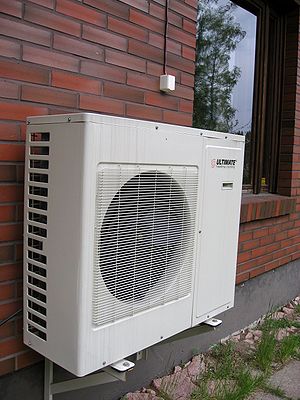
A heat pump system is a system that conveys heat from one area (heat source) to another (heat sink) by using mechanical work or a high-temperature heat source. The system uses either a compression heat pump or an absorption heat pump. Most conventional heat pump systems give off the heat directly to the indoor air, or to tap water (see solar thermal collector), or to water circulated for heating (radiators).
It is a device used to heat and sometimes also cool buildings by transferring thermal energy from a cooler space to a warmer space using the refrigeration cycle, being the opposite direction in which heat transfer would take place without the application of external power. Common device types include air source heat pumps, ground source heat pumps, ater source heat pumps and exhaust air heat pumps. Heat pumps are also often used in district heating systems.
The efficiency of a heat pump is expressed as a coefficient of performance (COP), or seasonal coefficient of performance (SCOP). The higher the number, the more efficient a heat pump is and the less energy it consumes. When used for space heating these devices are typically much more energy efficient than simple electrical resistance heaters. Heat pumps have a smaller carbon footprint than heating systems burning fossil fuels such as natural gas,[1] but those powered by hydrogen are also low-carbon and may become competitors.[2]
Use[edit | edit source]
The heat pump can be used to heat or cool a space or liquid. Also, it can be used to extract or pump heat either into or out of a space. For home heating, a heat pump can extract heat from outside air (even at temperatures below freezing), or from the ground through liquid circulated through subsoil pipes. This heat can then be transferred indoors. During hot weather, the cycle is reversed; heat is extracted from the indoor air and expelled to the outside, as in an air conditioner or refrigerator.
Operation of a compression heat pump[edit | edit source]
- Heating Cycle
During the heating mode, the outdoor coil is the evaporator and the indoor coil is the condenser.
- The refrigerant absorbs heat in the evaporator from the outdoor air, turning into gas
- The compressor raises the pressure of the gas, which also increases its temperature
- The hot gas then flows through the condenser coils that are inside the heated space
- The liquid then flows back through a pressure-reducing valve (capillary tube)to the outdoor evaporator coils, being cooled through expansion
- Cooling Cycle
During the cooling cycle the evaporator and condenser coils exchange roles. The direction of flow of the refrigerant is reversed with a special valve.
Operation of an absorbtion heat pump[edit | edit source]
See this wiki article. A schematic of the parts can be found at this Eandis document. An absorbtion heat pump is 170% efficient. However, whereas the compression heat pump can be powered by electricity, the absorbtion heat pump needs a fuel to operate. As such, it is still less ecologic (atleast if no renewable fuel is used).
Types of heat pump systems[edit | edit source]
- Ground-source heat pumps
- Water-source heat pumps
- Air-source heat pumps
- Geothermal heat pumps
The mentioned types of heat pumps are, besides the heat source, further divised to the type of working fluid they use. As such we have:
- air/air-source heat pumps, and air/water-source heat pumps under the Air-source heat pumps
- ground/water-source heat pumps under the Ground-source heat pumps
- water/water-source heat pumps under the Water-source heat pumps
Efficiency of the different types of heat pump systems[edit | edit source]
The efficiency used for heat pumps is not expressed in terms of the ratio of energy output to energy input, but expressed in terms of the ratio of energy output to work input. The measurement unit used for this is called the Coefficient of performance or COP. The higher the COP, the more efficient it is.
The COP for a heat pump in a heating or cooling application, with steady-state operation, is:
where
- is the amount of heat extracted from a cold reservoir at temperature ,
- is the amount of heat delivered to a hot reservoir at temperature ,
- is the compressor's dissipated work.
- All temperatures are absolute temperatures usually measured in kelvins or degrees Rankine.
Typical COP values for air conditioning and heat pump systems are in the range 2 to 4. With a typical electric resistance based heater 10 kWh of electrical energy will transfer less than 10 kWh of heat energy (because of some efficiency loss). A heat pump with a COP of 3.5 and 10 kWh of electrical energy can transfer up to 35 kWh of heat energy by using the electricity to pump energy from the environment.[3]
Which heat pump systems to use with private houses ?[edit | edit source]
Heat pump systems that attain their heat from the ground (water/water-source heat pumps use groundwater and so also fall in this "category") are the most efficient heat pump systems yet do require groundworks. Nevertheless, they are still the best choice to make for use in temperate countries (where it is cold during the entire day in winter, and where the air is hence cold all day too). It is best to use a system that can also run in reverse. This way, you can cool your house in summer with it, and immediatelly store this heat underground where it will be reused in winter. Systems that can run in reverse (active cooling) are often not recommended at all, but this is often due to the fact that they never take into account the stored heat (which helps to heat the house in winter).
In countries where it gets cold at night, but where it warms up during the day (ie subtropical countries/desert countries), an air/water-source system is best used.
Air-source heat pump systems are best not used at all. This, as it needs to be compatible to your ventilation system. So, if you don't use this you can freely decide your own ventilation system (for example a heat recovery ventilation system).
Fitting a heat pump system to a house in practice[edit | edit source]
Here are some helpful links:
Related projects[edit | edit source]
See also[edit | edit source]
- Growing under cover: the Strawbridge air/ground-source heat pump is a simple heat pump system for a greenhouse
References[edit | edit source]
- http://ebl.vlaanderen.be/publications/documents/38408
- https://www.greenmatch.co.uk/heat-pump
- http://www.eandis.be/eandis/pdf/9010014_Warmtepomp_Nl_01_12_DataId_5063929_Version_6.pdf
- https://www.renewableenergyhub.co.uk/main/heat-pumps-information
- ↑ "The UK is sabotaging its own plan to decarbonize heating". Retrieved 2021-06-06.
- ↑ "Can the UK rely on hydrogen to save its gas boilers?". 2021-05-21. Retrieved 2021-06-06.
- ↑ http://hyperphysics.phy-astr.gsu.edu/hbase/thermo/heatpump.html and http://www.powerknot.com/how-efficient-is-your-air-conditioning-system.html







